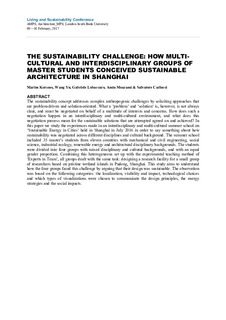| dc.contributor.author | Korsnes, Marius | |
| dc.contributor.author | Wang, Yu | |
| dc.contributor.author | Lobaccaro, Gabriele | |
| dc.contributor.author | Moazami, Amin | |
| dc.contributor.author | Carlucci, Salvatore | |
| dc.date.accessioned | 2018-03-05T09:44:12Z | |
| dc.date.available | 2018-03-05T09:44:12Z | |
| dc.date.created | 2017-11-30T13:56:18Z | |
| dc.date.issued | 2017 | |
| dc.identifier.citation | AMPS PROCEEDINGS SERIES. 2017, 187-198. | nb_NO |
| dc.identifier.issn | 2398-9467 | |
| dc.identifier.uri | http://hdl.handle.net/11250/2488493 | |
| dc.description.abstract | The sustainability concept addresses complex anthropogenic challenges by soliciting approaches that are problem-driven and solution-oriented. What a ‘problem’ and ‘solution’ is, however, is not always clear, and must be negotiated on behalf of a multitude of interests and concerns. How does such a negotiation happen in an interdisciplinary and multi-cultural environment, and what does this negotiation process mean for the sustainable solutions that are attempted agreed on and achieved? In this paper we study the experiences made in an interdisciplinary and multi-cultural summer school on ‘Sustainable Energy in Cities’ held in Shanghai in July 2016 in order to say something about how sustainability was negotiated across different disciplines and cultural background. The summer school included 35 master’s students from eleven countries with mechanical and civil engineering, social science, industrial ecology, renewable energy and architectural disciplinary backgrounds. The students were divided into four groups with mixed disciplinary and cultural backgrounds, and with an equal gender proportion. Combining this heterogeneous set up with the experimental teaching method of ‘Experts in Team’, all groups dealt with the same task: designing a research facility for a small group of researchers based on pristine wetland islands in Pudong, Shanghai. This study aims to understand how the four groups faced this challenge by arguing that their design was sustainable. The observation was based on the following categories: the localization, visibility and impact, technological choices and which types of visualizations were chosen to communicate the design principles, the energy strategies and the social impacts. | nb_NO |
| dc.language.iso | eng | nb_NO |
| dc.publisher | AMPS | nb_NO |
| dc.relation.uri | http://architecturemps.com/wp-content/uploads/2017/11/AMPS-Proceedings-9-Living-and-Sustainability.pdf | |
| dc.title | The Sustainability Challenge: How Multi-Cultural and Interdisciplinary Groups of Master Students Achieve Sustainable Architecture in Shanghai | nb_NO |
| dc.type | Journal article | nb_NO |
| dc.type | Peer reviewed | nb_NO |
| dc.description.version | acceptedVersion | nb_NO |
| dc.source.pagenumber | 187-198 | nb_NO |
| dc.source.journal | AMPS PROCEEDINGS SERIES | nb_NO |
| dc.identifier.cristin | 1520958 | |
| dc.relation.project | Norges forskningsråd: 209697 | nb_NO |
| dc.relation.project | Norges forskningsråd: 250146 | nb_NO |
| dc.description.localcode | Published by AMPS. Open Access. | nb_NO |
| cristin.unitcode | 194,62,40,0 | |
| cristin.unitcode | 194,61,1,0 | |
| cristin.unitcode | 194,61,55,0 | |
| cristin.unitcode | 194,64,91,0 | |
| cristin.unitname | Institutt for tverrfaglige kulturstudier | |
| cristin.unitname | AD fakultetsadministrasjon | |
| cristin.unitname | Institutt for arkitektur og teknologi | |
| cristin.unitname | Institutt for bygg- og miljøteknikk | |
| cristin.ispublished | true | |
| cristin.fulltext | postprint | |
| cristin.qualitycode | 1 | |
